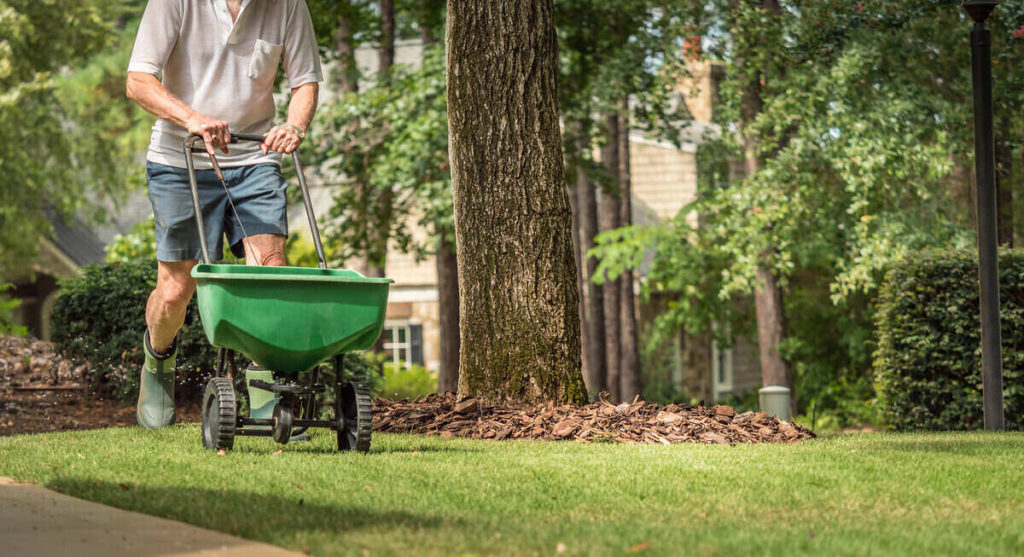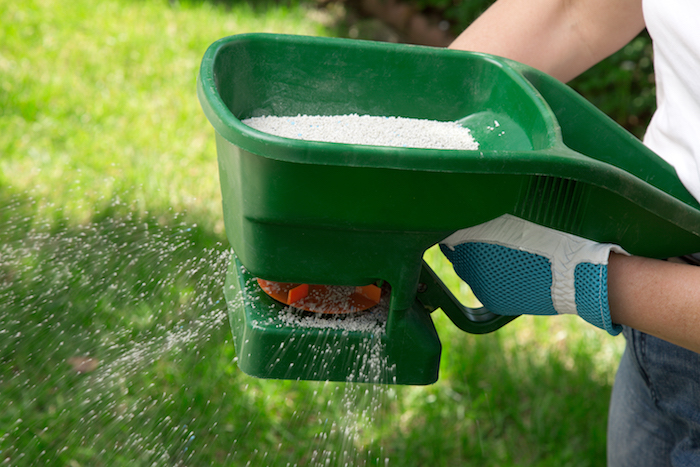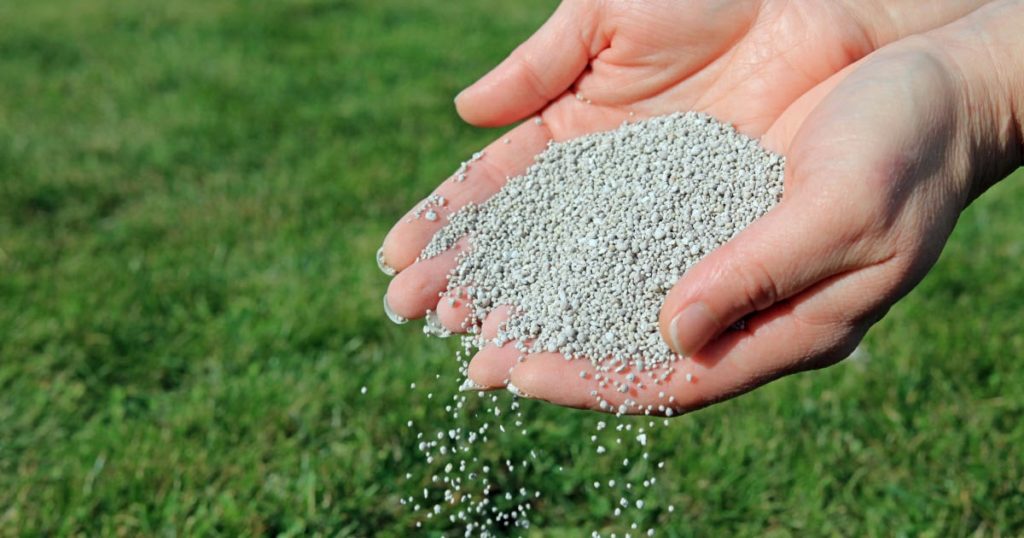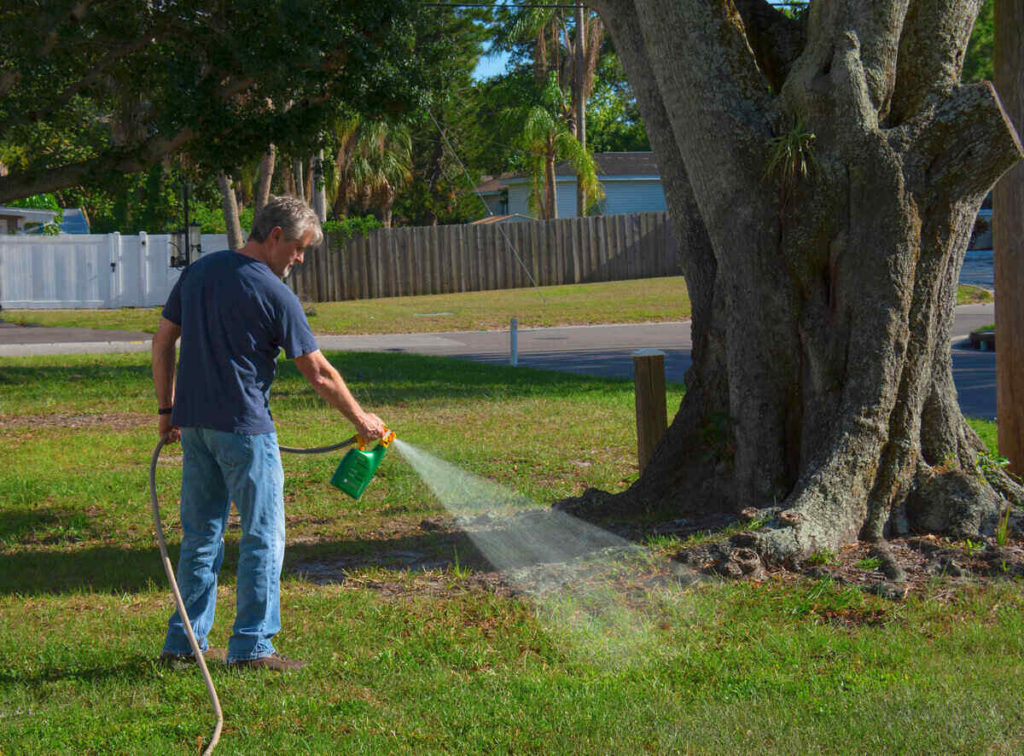Fertilizing your lawn now can ensure its long-term health and luscious appearance. There is a wide selection of lawn fertilizers and treatments available, each with its own benefits and drawbacks. These lawn fertilization tips can help you achieve a lush, healthy lawn and one that can survive the bad treatment it receives from kids and pets.
After the first fertilizer application has been finished, the correct procedure for fertilizing a lawn has to be carried out to maintain its good health and attractive look. Your yard will be able to withstand any weather, whether it’s a football game for the kids or a downpour, and it will look great the whole time.
Fertilizing your lawn consistently is also very important, a lawn that is fertilized consistently has a lower chance of developing diseases, insect infestations, and weed growth.
Tips For Fertilizing Your Lawn The Right Way

Fertilizing your lawn with the correct procedure is sure to yield the best result. Moreover, fertilizing properly is a skill in itself you need to learn properly. To enlighten you with the same, we have come up with some tips for fertilizing your lawn the right way.
1. Perform the soil test to check the pH level
To collect samples, you will need to randomly take ten to twelve soil samples from your lawn at three to four inches. Your soil sample should not include any roots or plant matter. Place about one cup’s worth of the soil sample mixture in the bag. Please send in the bag with your name so it may be examined.
First and foremost, get your soil tested. You will be able to decide on the kind of grass fertilizer you should use and the frequency with which you should apply it, depending on the investigation results.
A soil test will typically measure major nutrients such as phosphorus and potassium, which are essential to healthy root growth and recovery from environmental stress. If the soils in your yard lack these important structural components, your grass will suffer.
A soil test may provide you with a lot of useful information, one of the most important of which is the pH level of your soil. Generally, most grasses used for lawns prefer soils with a pH between 6.5 and 7.0.
Possibly, fertilizer won’t work if the pH of the soil in your lawn is too high or too low. Lime treatments are required for soils with a pH lower than 5.5 or 6.0 to “sweeten” the soil. To reduce pH levels that are more than 7.5, either soil sulfur or a lawn fertilizer that contains sulfur is necessary.
After testing the soil, if the results suggest an imbalance in pH or nutrients that need to be addressed, then trying the soil is a brilliant idea. Even if you are not experiencing any problems, you should go for a soil test once every three years to monitor your soil’s condition.
It is highly recommended to conduct a soil test towards the beginning of April, just as your grass is about to awaken from its dormant state throughout the winter. Under no circumstances should samples be taken after fertilizing the grass, else the data will be affected. Avoid using do-it-yourself kits wherever possible; although, being cheaper, they aren’t much accurate.
2. Decide on a Kind of Fertilizer to Use
Consider doing some research before deciding on the kind of fertilizer you should use in your garden. If you are confused about what to purchase, schedule an appointment at the garden center in your area. The following are some points to think about.
- Fertilizer can be obtained in either granular or liquid form. Fertilizers come in liquid formwork quickly, but since they are absorbed so quickly, they must be administered many times each week.
- Fertilizer can be obtained in either granular or liquid form. Fertilizers come in liquid formwork quickly, but since they are absorbed so quickly, they must be administered many times each week.
- Granular fertilizers may either have a quick or a slow release, depending on the customer’s preference.
- So, applying more than twice during the growing season is not essential when you opt for slow-release fertilizers. Slow-release fertilizers allow for a more even distribution of nutrients.
- There is a choice between organic and inorganic fertilizer. In the long term, applying organic fertilizer to your lawn rather than weed-killing fertilizer is better for the overall health of your grass.
Also Read: The Pros and Cons of Organic Fertilizer Every Gardener Should Know
3. To Avoid Over-Fertilization, Use Less Lawn Fertilizer and Spread it More Evenly
Reduce the pace of lawn fertilizer treatments by half, and then make two right-angle passes with your spreader to apply the fertilizer. At least three-quarters of people overfeed their lawns with fertilizer. Numerous retailers advocate the use of a four-stage fertilization process for residential gardens. Two inspections carried out annually are more than enough for most homes.
If you treat your lawn at the appropriate time of year according to the season, you can cut down on the amount of grass fertilizer you need. Lawn grasses need to get at least a certain amount of nourishment daily.
There isn’t always a direct correlation between quantity and quality. The overuse of nitrogen, phosphate, and potassium weakens the grasses on the lawn, which in turn makes the grasses more susceptible to disease.
If you fertilize your lawn too much, a layer of moss will form, ultimately suffocating the grass and killing it. If you use excessive lawn fertilizer, you will have to cut your grass more often. When you mow your lawn more often, you increase the risk of soil compaction, noise pollution, and wear and strain on your mower.
Applying fertilizer to a lawn more often than four times a year is not cost-effective. If you use less lawn fertilizer for your grass, you might save time and money.
4. Over-Fertilizing Or Late Fertilization
There are a lot of homeowners out there that don’t fertilize their lawns consistently. They only fertilize their lawn when they think it is in dire need of it or when they can get a good bargain on the product.
If you only fertilize your lawn once a year, you should use the fertilizer around Labor Day. At this point in the year, your grass has the most need for nutrients, and the quality and quantity of those nutrients will have the greatest influence.
Fertilization should be done after a long and challenging year of development and before the harshness of winter sets in. If you fertilize your lawn twice a year, the second application of lawn fertilizer should be around mid-October. This is like getting a second helping of much-required nourishment as they enter the winter.
In the middle to late spring, you can choose to use the crabgrass preventer with a third treatment. In the summer, you can add a fourth application.
Use extreme care when you are spreading fertilizer in the summer heat. If the weather is scorching and dry, you should avoid fertilizing your lawn at this time of year. One possible exception to this rule would be the usage of organic fertilizer.
They are far less likely to do damage to your grass during the hot day of summer. Your grass will benefit from a little fertilizer application in the spring, which will encourage new growth.
If you use half of the typical amount, it will be sufficient. When temperatures are consistently high, your grass will expand rapidly even if you do not apply fertilizer to it. The period between the end of spring and the beginning of summer is when grass grows at its fastest pace. Take advantage of this window of opportunity and do everything you can to foster healthy growth in your plants while they are here.
5. Be careful – Make sure to Spread it Carefully
To get a healthy, lush, and attractive lawn, administering it evenly with fertilizer would give the desired result. On the other hand, an uneven and haphazard application will become disastrous for your lawn and the environment as well.
The misuse of nutrients, not phosphorus, is the root of the environmental issues people face today. Too many people fertilize carelessly. Because they’re lazy or lack time, they are unconcerned by the minute quantity of fertilizer that runs off your lawn and onto the street.
While this may be the case, what if all of your neighbors shared the same system? You can do more good by controlling fertilizer consumption if you use less. It is not recommended to apply fertilizer in wetlands, rivers, streams, lakes, or ponds. Because of the high nitrogen concentrations in these kinds of water, they easily get infested with weeds and algae. Hence, fertilizer should not be applied within 6 to 8 feet of any body of water.
After fertilizing hard surfaces, such as your driveway, sidewalk, or street, you should make it a point to clean up after yourself thoroughly. Leaving fertilizer on these surfaces will result in the contamination of water features and storm drains.
It is not a good idea to apply fertilizer to frozen soil. You might easily place this if you are in a hurry to apply the crabgrass preventer in the spring. Crabgrass preventers should not be used under any circumstances, even when frozen ground.
How to Use a Fertilizer Spreader to Apply Fertilizer?

The frequency with which you fertilize your lawn is critical in the appearance of your grass and its maintenance. For instance, the more fertilizer you put on your lawn, the longer it will take you to cut it with the mower. Here are some ways mentioned below to use a fertilizer spreader to apply fertilizer.
1. Using a Broadcast or Rotary Spreader
A broadcast or rotary spreader is an excellent option to consider when you need to fertilize a bigger area of grass. Before loading the hopper, check to see that the lid has been securely fastened. If you fill it on a tarp, you can easily catch any fertilizer that spills while you are working.
Fertilizing the turf should initially begin at the edges of the grass, followed by a systematic, rhythmic movement throughout the surface. The application strips should overlap slightly to ensure that every blade of grass receives the same amount of coverage from the fertilizer.
2. Make use of a Drop Spreader
The drop spreader is the best option for accurate fertilizer application. At the end of each pass, you need to ensure that the hopper is properly sealed and check that you have enough coverage.
A drop spreader is an investment that will more than pay for itself if you own a lawn of a typical suburban size. If you made the mistake of dumping fertilizer on your lawn, use a stiff broom to scatter out any of the fertilizer that is still there.
You will need to give it a good soaking with water before applying it a second time a few days later to facilitate the movement of nitrogen from the soil to the grassroots.
3. The use of a Handheld Broadcast Spreader
A portable broadcast spreader is a fantastic option if you need to fertilize a small grassy area. As you walk, keep a consistent speed and slightly overlap the distribution patterns you’ve been using.
A little spreader such as this one is great when you have shadier areas of your lawn that need a different amount of fertilizer than the brighter regions of your grass.
In some instances, a single fertilizer application will provide both weed control and grass nourishment. A grass spreader is required to apply these weed-and-feed lawn care products.
4. Handheld, Pre-Calculated, Battery-Powered Spreader
Application is a breeze with battery-powered spreaders with pre-calibrated settings and can handle yards of any size. To water your lawn, you need not get out of your automobile or make any further effort.
This portable spreader is excellent if you have a small yard or live in a location where it would be difficult to move a normal push lawn spreader.
How to Spread Granular Fertilizer on a Grass Lawn

Granules, which are just little particles that have been dried up, are occasionally used to fertilize the grass. You are looking for granular fertilizers at this particular location.
1. Use a Spreader
As a result, the first stage in applying fertilizer is to decide what sort of spreader would work best for your yard. After you have made your pick, the next step is to adjust the proper application rate on your fertilizer spreader. Reading the label attached to the fertilizer’s packaging will provide you with the information necessary to determine the appropriate adjustment.
If you want to fill the spreader with fertilizer, you should do it not on your grass but on the driveway or another comparable hard surface. If you choose to proceed in this manner, any material accidentally spilled will not permeate into the soil, and your grass may be damaged as a result. You’ll need as much fertilizer as you need to cover the whole yard, so make sure the hopper is closed before you start.
2. Start at the Edge and Go Inward
Start by going around the outside of your lawn with a spreader, and then go inward. Maintaining a constant and moderate walking speed is the best way to ensure you cover the same ground. Applying fertilizer around the perimeter of the grass should be done while going back and forth across the lawn in a straight line, just like you would while mowing the lawn.
By overlapping your movements by a few inches between each pass, you may ensure that none of the places are overlooked. Continue moving forward until you have finished so that you may cover all of the grass.
3. Immediately water the Grassy Area
You should immediately water your lawn with a hose or sprinklers after applying fertilizer to guarantee that it will absorb the nutrients and remain healthy. The water will act like a piston, forcing the granules deeper into the soil, which will improve the capacity of the soil to absorb them.
3. Clear up
After fertilizing the grass, if any granules are left on the driveway or other hard surfaces, you should sweep them up and throw them away in the garbage. If you leave fertilizer out in the rain, it will eventually wash into natural rivers, contaminating those waterways.
Fertilizer should be stored in a cool, dry location away from mischievous pets and kids. Take out any excess fertilizer that is still in the spreader. After it has been used, the fertilizer spreader may be emptied and given a thorough cleaning with a hose. To prevent the spreader for your fertilizer from rusting, store it in a dry location.
How to Apply Liquid Fertilizer to Your Lawn?

Instead of granules, some lawn fertilizers are offered in liquid form or as a water-soluble powder that must be mixed with water before application. A hose provides these nutrients to your lawn in the appropriate amounts.
1. Make Sure Your Sprayer is Attached or Filled
Utilizing a sprayer directly connected to your garden hose is one of the most efficient methods to administer a liquid lawn fertilizer. It is also one of the most effective. You won’t have to dilute them on your own since the hose will do it for you automatically. Simply screwing it onto the hose is the only additional step necessary.
As a result, before applying fertilizer to your plants, you will need to prepare it by combining it with water in a separate container. The directions on the product packaging will inform you how much fertilizer and water are the appropriate ratios for your garden. First, the fertilizer must be diluted with water before it can be sprayed. Next, the diluted fertilizer must be poured into a backpack or handheld sprayer.
Also Read: How to Make Liquid Fertilizer from Dry Fertilizer – A Complete DIY Guide
2. Apply Fertilizer Evenly Throughout the Lawn
As you go in a zigzag path around your yard, spray your body in a circular motion from side to side. Take note of where the sprayer stops working so that you may pick up where it left off on the subsequent run. Be cautious not to overspray or miss any places while you are spraying. The application of liquid fertilizer might be difficult for inexperienced gardeners. In many homes, uneven lawns may be attributed to liquid fertilizer usage.
3. Wait A Few Hours Before Watering Your Plants
Wait at least 15 minutes after applying liquid fertilizer to your lawn before watering it. This will let the fertilizer take effect. You should not use water while applying fertilizer to your lawn since this will prevent the fertilizer from permeating the soil.
Before using the fertilizer, ensure it has been allowed to dry for at least two to four hours. After your lawn has become mostly dry, you should give it a good soaking with a lot of water so that the grass can take up the nutrients from the fertilizer.
4. Empty and Clean out Your Sprayer
To get rid of any lingering fertilizer in the sprayer, whether you use a handheld or backpack sprayer, you should rinse it off with a hose. Keep the fertilizer container where there is moderate temperature and out of the reach of pets and small children.
Conclusion
Fertilizing grass correctly is the easiest way to ensure that it continues to be healthy and lush, that it keeps its deep green color, and that it gives weeds a run for their money. Conducting a soil test on your property may provide valuable insight into the fertilizer that will work best for your grass and the season in which you should apply it.
You will need to choose a fertilizer application method before you can put it down. Give the grass one last watering to guarantee that the fertilizer will be taken up by the grass and not washed away. If you implement these suggestions, you will be rewarded with thick and vibrant grass.
